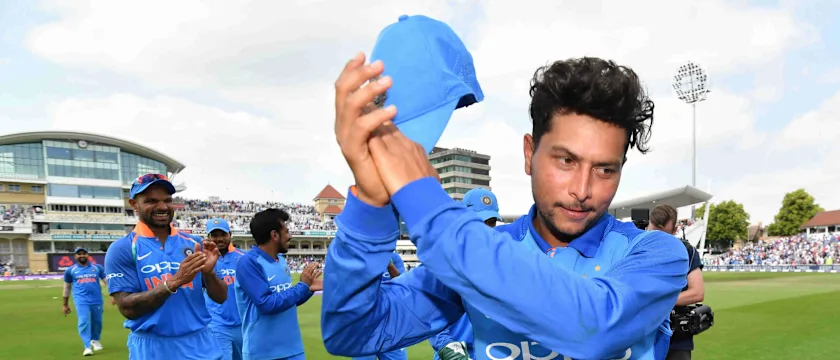‘The machine doesn’t have hands’ – Kuldeep Yadav

It was a pitch full of runs, and England started strongly, crossing 70 with Jason Roy and Jonny Bairstow inside 10 overs. That’s when Kuldeep struck. Thrice in two overs. Roy, Bairstow and Joe Root were back, and England were suddenly 82/3.
A gap, and he was back later in the innings, sending back Jos Buttler, Ben Stokes and David Willey. That the England total was well below par was evident when Rohit Sharma powered his way to a 114-ball 137* and India reached the target in just 40.1 overs.
What a day for @imkuldeep18 here at Trent Bridge. Picks up his first 5-wkt haul in ODIs and also becomes the first left-arm wrist spinner to pick up 6 wickets in ODI cricket.
— BCCI (@BCCI) July 12, 2018
Follow the game here - https://t.co/iWWklQz7H3 #ENGvIND pic.twitter.com/7eXJQMeKXe
Kuldeep started the tour with 4/21 and 3/16 in the two Twenty20 Internationals in Ireland, and then got 5/24 in the first T20I against England. Out came ‘Merlyn’, the spin-bowling machine, and Kuldeep failed to pick up a wicket in the second T20I in Cardiff and was dropped for the third game.
But he is back with a bang now, and put the wicketless performance in Cardiff down to “sometimes you get wickets and sometimes you don’t”. Nothing to do with bowling machines or videos.
“I think it’s wrong to try and judge someone from videos. It doesn’t work. You can get an idea, but only so much. And then the pitches change, so the bowling becomes very different,” said Kuldeep, who returned his career-best figures.
A dent at Trent with a different kind of a sixer today from @imkuldeep18. Simply brilliant bowling. #ENGvIND pic.twitter.com/gp14UzvZDI
— Sachin Tendulkar (@sachin_rt) July 12, 2018
“I don’t look at who the batsman is when I am bowling. I don’t believe in bowling machines. The machine doesn’t have hands or fingers. The ball turns, yes, but there is so much more a bowler can do that a machine can’t.”
One would expect Indian spinners to take time to settle down in England, but Kuldeep has fit in beautifully. Like in the first ODI, where no other bowler from either side really got on top of the batsmen.
“It was a grassy pitch, good one to bat on. They had started well, so I was looking to keep the runs in check and, at the same time, looking for wickets. Luckily, I got three wickets in two overs, and that really changed the momentum. I am enjoying the English conditions now. It’s perfect for spinners who are turning the ball,” he said.
“I didn’t try anything new. I just stuck to my basics and bowled wicket to wicket and varied my pace and used my variations. Most of the cricket I have played over the years has been on cement pitches. If I can turn the ball there, I am lucky, I can turn it on most pitches.
“It needs to be in your hands, your fingers, if your pivot is good. If it’s turning here, it should turn anywhere. You need to have a big heart, and not feel pressured.”
The second ODI will be played at Lord’s on Saturday, 14 July.
